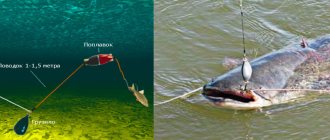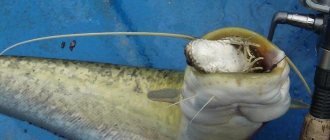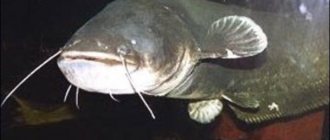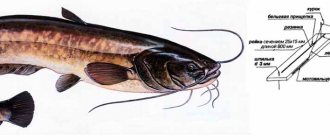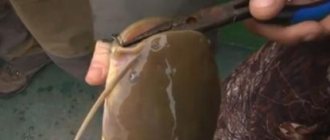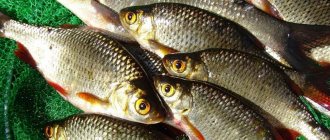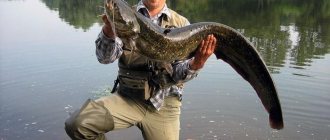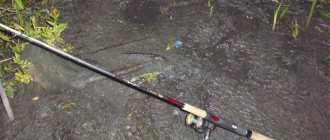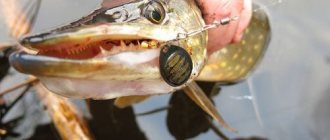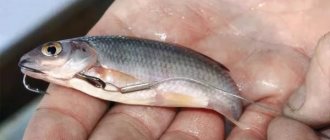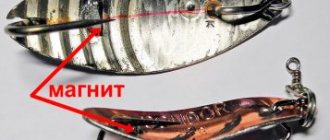Yuri 10/12/2020 325
Catching catfish with a spinning rod requires serious preparation from the angler. It is necessary not only to first study the features of the bottom topography of the local reservoir, but also to have an idea about the lifestyle of the river ruler and his habits.
The largest freshwater fish offers decent resistance when fished. Therefore, properly mounted spinning tackle is one of the important components for successful hunting.
Places and times for catching catfish
The right place to catch this species is half the success of successful fishing . Large fish can be found in different parts of the reservoir, everything will depend on the time of year . For example, in the spring months , catfish most often emerge from the winter hole onto shallows, river mouths or small islands.
Another thing is summer , when catfish travel throughout the entire pond or river. It can hunt from under overhanging trees, deep holes, sunken boats; during this season you can find catfish while hunting in the area of washed-out shores.
As soon as autumn cooling , the freshwater predator hides. In the fall, he tries to “lie down” in wintering pits, where he intends to fatten up.
Autumn is considered an excellent time of year for catching catfish with a spinning rod . At the first frost, the fish's intuition prompts them to leave their places of shelter in search of food.
But at very low temperatures, the catfish hibernates. So, if the water drops to 7 degrees , the fish stops responding to spinning baits.
A good time of year for fishing for catfish is spring , since at this time the fish begin to eat. The freshwater predator hunts by waiting in holes.
The catfish becomes active as soon as the water warms up to 10 degrees.
Summer fishing will be successful at night; catfish most often feed in shallow water and in areas of the reservoir overgrown with algae.
And in the heat of the day, the predator lies down at the depths of the reservoir in the cool.
The most successful weather for catching a giant is a warm day and southwest wind .
If the rains are warm, they do not harm fishing.
Successful fishing will be in the morning (until 8-9 o'clock) and in the evening - from 5-6 o'clock until dark .
Catfish search places
This representative of the ichthyofauna prefers great depths and snags. He will never live in shallow water and on a clean bottom. The predator tries not to leave the area of residence and only occasionally goes to nearby rifts and dumps.
In rivers and reservoirs, catfish should be looked for in the following characteristic places:
- deep holes, whirlpools, reaches and return streams;
- wells, snags and other rubble;
- extended channel ditches.
Catfish do not like strong currents, so you can rarely find them in straight areas. The presence of any anomalies at the bottom is also mandatory. This underwater inhabitant needs shelters where he rests and lies down after hunting.
The catfish leads a solitary lifestyle. Therefore, a maximum of two or three individuals can live within one promising point. If the fish is large in size, then it occupies the shelter alone, driving away other weaker competitors.
Photo 2. You need to look for catfish near washed-out shores.
Which spinning rod to choose?
It is not an easy task to catch fish that grow up to 100 kg , which also affects the equipment of the spinning rod.
The spinning rod for catfish must be powerful and durable and at the same time very flexible . Fishing for catfish sometimes lasts an hour or more. Since you will have to fish in the pits of a reservoir, the spinning rod must be at least 3 meters long .
Let's look at how to assemble a spinning rod for catfish:
- Rod . The choice depends on the choice of fishing location and fishing method. For spinning fishing, a rod up to 150 grams . a plug, fiberglass or composite rod is perfect . The presence of powerful rings is welcome. The telescopic option will have to be abandoned.
- Reel _ It must match the rod. A spinning reel should be chosen at least 200 m . Multiplier and spinning reels are perfect .
- Fishing line . The choice will have to be made between braided cord and monofilament line. You need to choose a fishing line no weaker than 30 lb. The fishing line for spinning is selected to be strong; it is better to use braided line .
- Leash . We need leashes that do not wear out for a long time. Kevlar will do , the fishing line and cord will quickly fray the fish.
- Hook . Must match the bait, single and treble hooks are used. But you need to choose the forged version , it is stronger.
According to the magazine’s editors, the domestic version of the Extreme line-Z 702 UL 0.6–7 g spinning tackle from Serebryany Ruchey is considered the most successful. Best selling Cat-Fish rod, A-elita brand.
Basic lures
You can choose different baits for catching catfish. Catfish react to spinners, wide spoons, and do not disdain wooden Orenos. However, you need to remember that for catfish you need to choose something heavier , and it is always easier to cast it with a long and powerful rod.
The predator pecks with pleasure :
- for fish
- frogs,
- artificial bait - polymer-rubber or foam fish of all types.
Fish spend almost all their time in holes, so spinning baits must reach any depth .
To catch catfish using a spinning rod, you can purchase the following baits :
- Spinner baits are heavy and large baits.
- Huge sized jigs.
- Wobblers are baits for large depths.
The color of the bait does not matter for catfish: its eyes are small and it is blind, but the size of the bait . The larger the bait, the larger the fish will covet it.
Since the catfish attacks bait located 20-30 cm away . from the bottom, or even passing above it, then for spinning it is better to use:
- oscillating spinners,
- silicone vibrating tails,
- diving wobblers with strong penetration.
Fishing technique
There are few ways to catch catfish using a spinning rod; the most common is jig fishing. Let's take a closer look at each method:
With this option, the fisherman taps all the holes and the bottom with the jig head. The spinning fishing technique must be chosen depending on the fishing location. For example, on a river, stepwise wiring will be useful: 2-3 turns of the reel and a slight jerk, then again 3-4 turns and a jerk. Wiring should be done so that the bait a little carried away by the obstacles, and it moved in weak jerks, imitating a wounded or sick fish. You need to do so many “shots” with a spinning rod so that there are no not a meter of unchecked area bottom near obstacles.
Jig method.- Wobbler fishing method . How does a red rag affect a bull on a freshwater predator? Fishing with wobblers using cranks . The fisherman taps the bait on the bottom, creating turbidity, as if a fry is feeding. On the lake, you need to “tap” all promising depressions in the bottom with a sinking wobbler. The nature of the wiring is almost the same as on the river, but a little faster , since the current helps on the river, but here the water is standing: 3-4 turns of winding the reel and a small jerk with the spinning whip, again 2-3 turns and another jerk.
- Flashing . Fishermen use large spoons , with the help of which they raise the turbidity on the bottom. Wiring is a winding of the cord, which must be done after a short pause.
As for the bite, it is sharp in catfish and is almost no different from a “dead” hook , which comes to life after a few seconds. If the fisherman is inexperienced, he may not immediately understand what he has hooked: a snag or a fish.
The catfish immediately sucks up the bait , since it has practically no teeth. The hook must be done sharply so that the hook's sting penetrates the rough skin of the predator's mouth.
Catfish almost never get off the hook, but fishing is very tiring . You first need to exhaust him so that he gets tired, and only then drag him to the shore or boat. You must not give slack to the fishing line, otherwise the catfish will either go into the snags, or will accelerate and break the fishing line at speed.
Where to start choosing?
The choice of any gear should always begin with determining the place and fishing conditions, the type of bait and with determining the expected size of the trophies.
In order to determine the fishing location, you need to know where to look for catfish in a given period, in a given body of water. There is an opinion that the correctly selected place for catching this predator is already half the success , the other half is the correctly selected spinning rod for catfish.
The behavior and habitats of catfish differ in the autumn and spring-summer periods. In autumn, when the water is cold, large specimens should be looked for in holes, among flooded snags at depth. It rarely walks around the water area of the reservoir; it waits for its prey in its favorite places at depth.
As the water warms up, in the spring the catfish begins to more often go out to the shallows , to small islands and bays. He becomes more active.
In summer, catfish travel throughout almost the entire reservoir in search of food. To find it, fishermen have to try very hard, constantly moving by boat across the pond or on foot along the coastline.
By winter, when the water cools below 7 degrees , the catfish goes into hibernation and practically does not react to spinning baits.
You can hunt for it both from the shore and from a boat, using a wide variety of baits (wobblers, jigs, imitation frogs, etc.). Considering the size of this fish, it sometimes reaches 100 kg. weight, it is clear that baits for it cannot be small.
Expert opinion
Knipovich Nikolai Mikhailovich
Zoologist, hydrobiologist. I am interested in fishing at a professional level.
Interesting! A large catfish, after being hooked, does not move very actively, so the fisherman often has the feeling that the tackle has been snagged. Active resistance begins closer to the surface of the water.
After determining the place and fishing conditions, as well as the types of bait, you should, in accordance with these parameters, choose a spinning rod for catching catfish with the necessary quality characteristics. These characteristics include:
- Rod design.
- Length.
- Test.
- Build.
It is also important to consider that you need to take only high-quality products made of graphite or composite materials.
Graphite spinning rods are the lightest, most balanced and sensitive, but quite expensive. Composite rods are somewhat cheaper and somewhat heavier, but are also quite strong and sensitive.
Let's take a closer look at each of the quality characteristics.
Design
Currently, spinning rods are produced in three designs: solid, plug-in and telescopic.
It should be noted right away that rods of a telescopic design are of little use . This is due to the fact that, due to the design features, they are not the most durable and reliable; with sufficient load, one of the docking units may not withstand. Considering the strength and size of catfish, they can only be used for catching small, up to 5-7 kg, specimens, which in the case of this fish is not even interesting.
Solid, high-quality spinning rods may be the best option for catching catfish , they are the most balanced and durable, but due to the fact that their length is constant, they are very inconvenient to transport. Therefore, such rods are used only at specialized camp sites and among fishermen who live near the fishing spot.
The most practical type should be considered plug-in spinning rods. A plug-type spinning rod for catching catfish, depending on the length, can consist of 2 or 3 legs .
Length
The length of the rod should be selected depending on the free space that you will have in the fishing area, as well as on the required casting distance of the bait. But in any case, to catch this predator you need to choose the maximum possible rod length , within reasonable limits, of course. The longer the fishing rod, the better it handles the resistance of the fish when fishing.
For example, a spinning rod for catching catfish from a boat should be taken from 2.1 to 2.4 meters . These sizes will allow you to comfortably control baits in cramped conditions, as well as make fairly accurate casts at the required distances.
When fishing from the shore, choose rods from 2.4 to 3.2 meters . If you need very long casts of bait, you can stick to rods up to 3.6 meters long.
Test
Due to the fact that fairly large and heavy baits are used for catching catfish, it is rational to choose sticks with dough from 40 to 120, and sometimes up to 160 grams . Such rods belong to the heavy class ( “H” HARD ), which are designed for baits weighing up to 60 grams. Or to the super-heavy class ( “XH” EXTRA HEAVY ), which are designed for handling baits over 70 grams, sometimes up to 250 grams.
Expert opinion
Knipovich Nikolai Mikhailovich
Zoologist, hydrobiologist. I am interested in fishing at a professional level.
Attention! It is not rational to take a rod with the biggest test for the future. The test must accurately match the weight of the baits you use, this is reflected in the effectiveness and catchability of the gear.
Sticks with less dough can only be used for catching small and medium-sized specimens, up to 20 kilograms.
Build
The structure of the rod determines its behavior during the occurrence of various bending loads that occur during casting baits, when hooking fish and when playing. Also, this characteristic is directly related to the sensitivity of the blank, the most sensitive are ultra-fast action rods , the most insensitive are slow action rods .
For catfishing, a compromise is necessary , since the most sensitive rods (super-fast action) are also the stiffest, they are not able to adequately resist the strong resistance of such large fish. And slow-action rods are not very sensitive, and you may be late with the hook.
parabolic (medium) spinning rods for catching catfish . They will help you bring out a worthy trophy and let you feel a normal bite. In addition, such sticks can cast baits quite far.
How to catch catfish using a spinning rod from the shore and from a boat
Catching catfish with a spinning rod from the shore and from a boat differs significantly from each other . Catfish are mainly nocturnal fish and practically do not take bait during the day. In addition, he is a sedentary inhabitant of the reservoir and does not go far from his lair unless there is food nearby.
To lure it out when fishing from a boat , various devices are used. The most common is kwok . Kwok is used from a boat. The bait hangs from the boat to a depth of 2-3 meters from the bottom (depending on the depth of the hole in which the catfish can stand), and the fisherman croaks through the water and makes sounds similar to slurping.
The catfish thinks that another predator is having lunch, but he will never tolerate a rival nearby, and will definitely come out of hiding. This is where the dangling bait catches his eye.
They also use an odorous lure : a bag of rotten fish and bait are hung under the boat. Catfish have a good sense of smell; besides, they are scavengers and can detect this smell at a great distance. He will come up and hit the bait.
Bait can be:
- slave,
- frog,
- cancerous cervix,
- bunch of worms,
- shell meat,
- stag beetle larva,
- called “oil seal”,
- meat of animals and poultry.
From the shore, catfish are caught only at night and using bottom tackle : a sinker on the bottom, and a leash of 20-30 cm. with a 2 or 3 hook hook.
The bait is the same as when fishing from a boat , but you can also use live bait. Bait : rotten fish, submerged in a bag not far, or better yet, a little upstream, from the bottom fishing rods.
- 5 secrets of catching crucian carp - exclusive material for our readers!
- Are you planning to catch asp using a spinning rod? Then this article is for you.
- Traditional fishing for non-traditional fish - taimen on a spinning rod
Catching catfish using a spinning rod, reservoir
Catfish are found much more often on reservoirs than on lakes. Here, catfish are localized mainly in natural depressions or holes that were formed before filling the reservoir, or in the deepest places in the riverbed. That is why, for a successful hunt for this predator, it is necessary to study the bottom topography as much as possible. The most likely sites for catfish are most likely located in sections of the riverbed where the depth is from 2 to 3 meters. Flooded bushes, stumps, trees, and other underwater objects provide excellent shelter for a predator. It is advisable that there be a slight current in these areas, because in water that is saturated with oxygen there are many more potential victims of catfish.
In the conditions of a reservoir, the wiring trajectory should be directed mostly against the flow, and in some places across this flow. It is necessary to move the tackle evenly and slowly, as close to the bottom as possible. One of the most attractive baits for catfish when fishing with a spinning rod is an eight to ten centimeter wobbler, which has an eyelet for tying a fishing line, which is located in the center of a deepening, rather large blade. This actively working and well-burrowing wobbler is often “armed” with two powerful tees. Due to deep wiring and low water transparency, its color is of secondary importance. Some fishermen believe that catfish choose baits that are painted like a small bee.
It should be noted that sometimes catfish on a hot day (especially in summer) begin to fatten in the upper layer of water. This “strange” behavior of catfish occurs in maximum heat, at low pressure and shallow water depth. At the same time, the fish can behave in different ways: it either quietly and slowly moves under the very surface of the water in search of prey, or it reveals itself by loud slapping of its tail on the water. Fishing from the bottom during these hours is fruitless.
It is necessary to use a small wobbler, and it should be driven almost in the top layer or in the middle layers. The pace of the retrieve is a little faster than when fishing from the bottom. When fishing, you need to take into account that the catfish moves quite often in different areas, so you need to be patient. Also, medium and sometimes small oscillating and spinning spoons can be used as bait.
